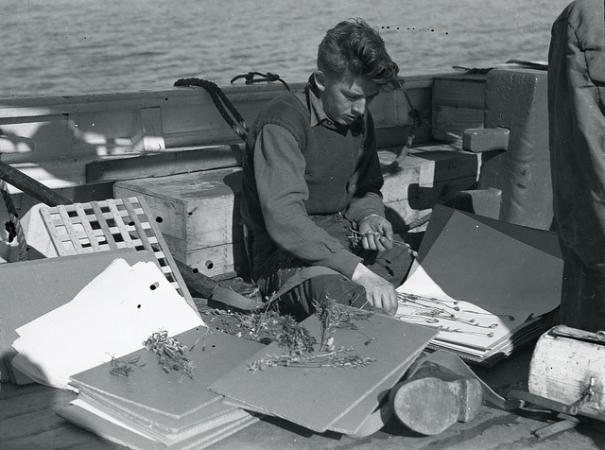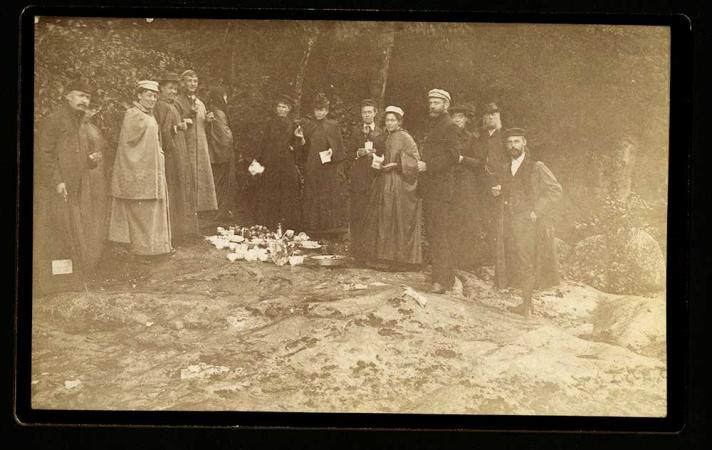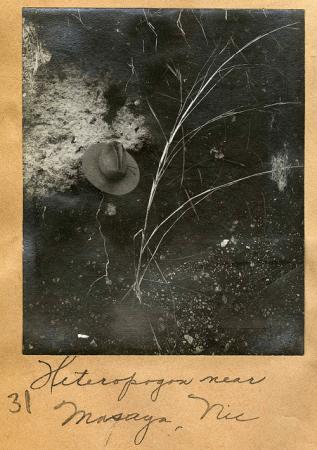
The intense efforts that started the Field Book Project and have kept it in high gear are slowing down to a sustainable pace. After almost ten years, grant funding for the Field Book Project has drawn to a close, but there is still plenty more to look forward to. What began as an initiative to catalog the field books in our archival collections has transformed into a massive digitization effort that will benefit researchers for years to come.
![Page 68 of Donald Erdman's journal, which includes a drawing of a red and black Labrid [sic] and Epinophelus. Smithsonian Institution Archives Record Unit 007428 Donald S. Erdman Papers, 1948. Image no. SIA2014-06725 Page 68 of Donald Erdman's journal, which includes a drawing of a red and black Labrid [sic] and Epi](https://siarchives.si.edu/sites/default/files/styles/body-image-450/public/blog-attached-images/SIA2014-06725.jpg?itok=xpzXGF--)
The Field Book Project began in 2010, when the Smithsonian Institution Archives and National Museum of Natural History teamed up to make field notes by naturalists, scientists, and about expeditions affiliated with the Smithsonian more easily discoverable by researchers. The first step was to create an online catalog of the field notes in our collections. The initial goal to catalog 6,600 field books was reached, then handily surpassed. As a result, biodiversity materials were more easily discoverable to researchers. Another result was a marked increase in demand for the materials. Researchers wanted more field notes cataloged, digitized, and at their fingertips. To meet the demand for further access, the project’s scope expanded to include goals of preserving at-risk field books and of conducting high-volume digitization. These efforts were generously funded by funders including the Council for Libraries and Information Resources, Save America’s Treasures, and the Smithsonian Women’s Committee.
Nine years later, we have surpassed the initial goals and cataloged 9,508 separate field books. With a grant from Save America’s Treasures, we’ve conducted preservation assessments on all of the field books and performed conservation on the most at-risk items. Today, we are quickly approaching 4,200 field books digitized.
We recently wrapped up the project’s most recent grant from the Arcadia Fund, cataloging over 2,000 new field books and digitizing over 2,600 field books destined for online access through the Smithsonian Collection Search Center, the Biodiversity Heritage Library, and the Digital Public Library of America. Along the way, the Internet “crowd” took a keen interest in our field books, too. For the past six years, they have worked together to transcribe those handwritten resources through the Smithsonian Transcription Center. The effort of these “volunpeers” have made it possible for the full text of 400 field books to be searched, and new data mining and computational analysis techniques brought to bear by today’s scholars. Some previously unrecognized collectors, like Mrs. Katherine Ross (Davis) Galliard (1866-1937), have been identified as a result.

All of this has happened through the diligent efforts of teams of catalogers, conservators, imaging specialists, and interns who we’ll miss greatly as these first big efforts wind down and the remaining work gets folded into our daily operations. But first and foremost, our gratitude goes to our principal investigators, former Archives director Anne Van Camp and Botany Collections Manager Rusty Russell of the National Museum of Natural History, who inspired this work and saw the Field Book Project through its first eight years.
As we look forward to the future and the work that remains, it’s satisfying to know that with digitization, field observations of biodiversity researchers a century and a half ago can now be carried back into the field by the researchers of tomorrow.

Related Resources
- Smithsonian Field Books Collection, Biodiversity Heritage Library.
- "Hidden in Plain Sight: Reading Between the Lines with Smithsonian Transcription Center Volunteers," by Meghan Ferriter, The Bigger Picture, Smithsonian Institution Archives
- "Women in Science, in the Field," by Lesley Parilla, Field Book Project
Produced by the Smithsonian Institution Archives. For copyright questions, please see the Terms of Use.

Leave a Comment